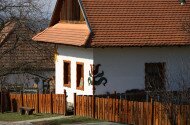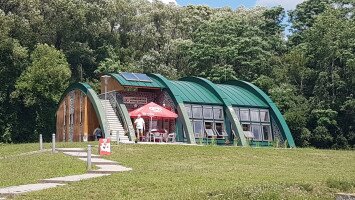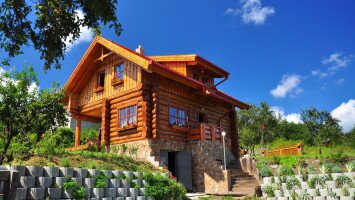Hollókő Magyarország egyetlen faluja, amely az UNESCO világörökségi listán szerepel, és így világszerte ismert.
A Világörökség Bizottság 1987-ben a magyarországi várományos helyszínek közül Budapest mellett elsőként a Nógrád megyei palóc falut, Hollókőt vette fel a Világörökségi Listára. A legfontosabb feltételnek, azaz az egyedi és egyetemes jelentőségnek Hollókő azzal tesz eleget, hogy a 17-18. században kialakított falu a hagyományos településformáját, a tradicionális építészet és a 20. századot megelőző falusi élet páratlan példája, melyet sikerült eredeti állapotában megőrizni. Hollókő szelíd és harmonikus szimbiózisban fejlődött a természettel és napjainkra sem vált Szabadtéri Múzeummá: mindmáig élő, lakott település. Hagyományőrző lakói az épületek nagy részét jelenleg is rendeltetésszerűen használják. Festői környezetben, a megőrzött falukép együttesében működik az a falumúzeum 1964 óta, amely egy jellegzetes palóc parasztcsalád életmódját, lakását, bútorait viseletét és gazdasági eszközeit mutatja be.
Fekvése, megközelítése
A település Nógrád megye középső részén Szécsény várostól délkeletre, Pásztó városától északkeletre a Cserhát-hegységben található meg. A mindössze pár száz fős település Ófaluja a világörökség része. A falu kizárólag közúton Szécsény irányából, és a 21. számú főútról Pásztó előtt lehajtva a 2122-es számú mellékútra, közelíthető meg.
Története
A falu története a XIII. századig nyúlik vissza, a tatárjárás után épült fel a Szár-hegyen vára. A sziklára épített erődítményhez egy régi legenda fűződik, mely a helyiek szerint a település nevére is magyarázatot ad. Történt, hogy bizonyos Kacsics András elrabolta a szomszédos földesúr szépséges asszonyát, s épülő várába zárta. Az asszony dajkája azonban, aki "boszorkány" volt, szövetkezett az ördöggel, és rávette őt, hogy fiai változzanak hollóv és az asszonyt körülvevő erődítményt kőről kőre lebontva szabadítsák ki őt. A hollófiak így is tettek - becsületükre legyen mondva, nem szórták szerteszét a köveket -, hanem egy közeli bazaltsziklán új várat raktak belőlük. Ez lett Hollókő vára, a várrom alatt elterülő falu pedig Hollókő. A nevét igazából a vár alatti területről (ami a hollók kedvelt szálláshelye volt), kapt, a települést pedig a várról nevezték el.
Mivel a korabeli oklevelek jobbára csak a várat említik, a faluról a középkorból pusztán az a tény ismert, hogy már a XIV. század első felében egyházas hely volt. A török hódoltság idején sok más településhez hasonlóan Hollókő is elnéptelenedett: 1715-ben mindössze három adóköteles háztartásról szólnak a vármegyei összeírások. Újratelepítése hamarosan megtörténhetett, hiszen 1720-ban már nemes községként szerepelt a nyilvántartásban (ez azt jelentette, hogy lakói mentesültek az adófizetés kötelezettsége alól). A környék kedvezőtlen termőhelyi adottságai miatt hosszú időre megrekedt a település fejlődése. A településen többször pusztított tűzvész, mivel a házakat fából építették, alapozás nélkül, és könnyen gyulladó zsúptetővel fedték, a szabad tűzhelyek felett pedig kémény helyett csak füstlyukakon szellőztettek. Az 1909-es nagy tűzvész jelentette a fordulópontot: az immár vályogfalú házakat kőalapra emelték, és szarufás tetőszerkezettel, cserépzsindellyel fedték, megőrizve eredeti formájukat.
Ófalu
Hollókő a régiót jellemző, egyutcás falutípust képvisel, melynek alapstruktúráját a központi útra merőlegesen, keskeny szalagtelkeken elhelyezkedő házak kettős vonala jelenti. A palóc településeken a nagycsaládok szokás szerint egyetlen telekre építkeztek, és a család létszámának növekedésével az utcára néző első ház mögött egyszerűen egy újat emeltek. A falu központjában, a domb tetején kialakított "szigeten" áll a kis fatornyos, zsindellyel fedett templom, melyet 1889-ben közadakozásból építettek. Az épület kivételesen jó állapota és egyszerűségéből fakadó szépsége miatt valóságos kis ékkő.

A ma nem egészen 400 lelket számláló település közepén elhelyezkedő műemlékcsoport összesen 67 védett épületet foglal magába - ezek többnyire földszintes, kontyolt nyeregtetős parasztházak, melyek homlokfalát az utca és az udvar felől is áttört faragással díszített faoszlopos, deszkamellvédes tornácok ("hambitusok") szegélyezik.
Múzeumok:
- Falumúzeum (Kossuth u. 82.): bemutatja a 20. század eleji tipikus hollókői házbelsőket. Időszakosan látogatható:április 1-től október 31-ig.
- Postamúzeum (Kossuth u. 80.): A palócföld postája című állandó kiállítás két szobában mutatja be a több megyére kiterjedő néprajzi csoport, a palócság postahálózatának fejlődését és a velük összefüggő postai emlékeket.
- Vármúzeum (Várdomb): több helyszínen mutatja be a vár helyreállításának terveit, a várrekonstrukciós munkákat, valamint a feltáráskor megtalált eszközöket.
Újfalu
A Nógrád megyei falu már a cím 22 évvel ezelőtti elnyerését megelőzően is kedvelt üdülőtelepülésnek számított, azonban a világörökségi rang újabb csábítást jelentett. A falu lakóinak 70%-a nyugdíjas, az átlagéletkor 50 év felett van. A település művelődési háza 150 fő befogadóképességű. A helyi általános iskolában csak alsó tagozat van. A felsősök a 18 km-re lévő Szécsényben tanulnak. A községben napköziotthonos óvoda működik, s nem kell bezárni a születések hiánya miatt.
Főbb nevezetességei, látnivalók
- Ófalu (Kossuth utca és Petőfi utca) - falurezervátum, 56 védett épületet foglal magában
- Hollókői Tájvédelmi Körzet
- Falumúzeum Hollókőn (Kossuth Lajos utca 82.)
- Postamúzeum
- Hollókői Tájház
- Babamúzeum
- szövőházak (Kossuth Lajos utca 92. és 94.)
- Kelemen Ferenc fafaragó kiállítása és háza (Petőfi u. 2.)
- katolikus templom (a 19. század végén épült, fatornyos épület)
- Hollókői vár























